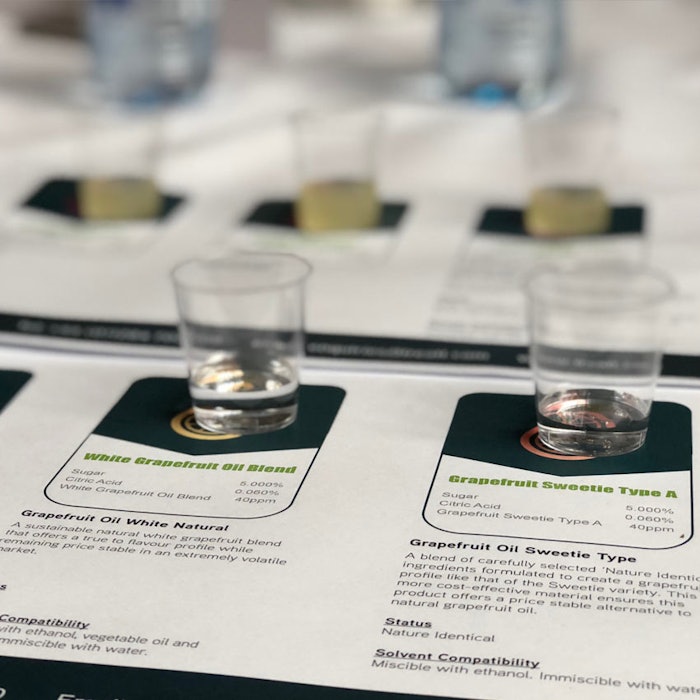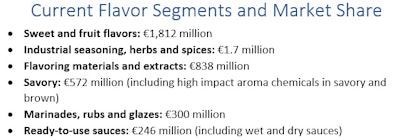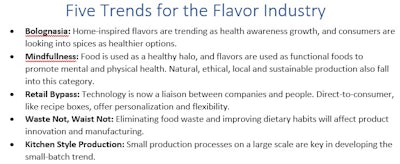
This year’s 10th annual FlavourTalks, which took place March 14-15, 2018, at the Barbizon Palace Hotel in Amsterdam, Netherlands focused on the topic “The Future of Flavors in Europe – Opportunities, Trends and Challenges,” with keynote speaker Professor Charles Spence, head of the crossmodal research laboratory, University of Oxford. The event featured 28 exhibitors who presented 240 materials, a new record for the exhibition, according to the event organizer, David Baines.
Citrus Takes Center Stage
Allergen-free nut flavors, clean label, fermented and ingredients typically reserved for fragrances were among the highlights that reflected the innovative wellness space explored by flavor companies. Citrus, floral and tropical flavors were among the most popular to taste.
Citrus was spotlighted during the tabletops. Due to the current volatile state of the industry, companies were showing off citrus replacers and cost-effective naturals via fermentation.
Bedoukian’s pomelo aldehyde is currently under consideration for FEMA approval and EU regulations. The molecule was presented on a blotter and exhibited a fresh grapefruit character with other waxy citrus peel notes, which can be used to enhance fresh, juicy pulpy notes in citrus flavors, such as grapefruit and pomelo.
Dohler’s citrus replacers are designed to develop a range of standard to premium juices. As citrus greening continues to wreak havoc on Florida’s citrus crops, the company’s portfolio of oils, essences and fractions adjust juice profiles ranging from juicy, fleshy, sweet, peely and green. The company also featured cashew, which exhibits a fruity and juicy taste; as well as acerola, which imparts woody and fruity notes; and finally, green and fresh watermelon.
Isobionics highlighted its range of fermented and pesticide-free nootkatone and valencene materials. The natural nootkatone (70% by fermentation) was described as a clear, yellow liquid having a typical grapefruit woody top note and grapefruit woody taste. Natural valencene (75% by fermentation), a clear colorless liquid, exhibited a sweet woody orange top note and a standard orange taste.
Treatt featured two grapefruit oils that offered price stability in a volatile citrus market. The grapefruit oil white natural is described as sustainable with a true-to-flavor profile; whereas the grapefruit oil sweetie type is a cost-effective alternative to the natural oil.
Lluch Essences’ folded lemon oils used patented processes to obtain the full aromatic profile of the oils. The company featured its folded lemon oil (5X) premium and folded lemon oil (10X) premium. Also featured was West African ginger oil obtained by steam distillation. Rich in citral aldehydes, the oil was described as clean and fresh.
Orris was a popular flavor ingredient, particularly in beverages. IFF LMR, Omega Ingredients, Biolandes and Firmenich featured the floral ingredient as a possible application in seltzer and juice beverages. Firmenich’s orriscience CTE 8% exhibits powdery, floral, creamy notes with a long-lasting effect and works well in red exotic fruit flavors. Biolandes’ orris absolute lands 68% irone was described as a floral-violet with woody and fatty characteristics.
Savory Solutions Made Simple
Savory and spicy were featured prominently, with a focus on peppers and smoky flavors, a reflection of the growing consumer demand for new flavors and tastes in the category. According to a Market Insights report, the global meat flavors market is expected to grow at a CAGR of 5.8% from 2018 to 2023. Additionally, the global natural meat flavoring market accounted for $ 833.03 million in 2016 and expected to grow at a record CAGR of 6.4% during the forecast period.
Mane presented its range of concentrated juices and extracts, including boiled chicken concentrated juice, boiled beef concentrated juice and a locally sourced onion concentrate juice from its partner Agrival in Brittany, France. The company also featured a white fish extract, which exhibited a codfish profile, and a green crab extract that exhibited crab flesh and shell notes to seafood applications. Robertet featured its range of pepper CO2 extractions, some exhibiting floral tastes and cooling effects in select applications. The Tasmanian pepper CO2 extract exhibited a basillike flavor with a tingle, while the Bengal CO2 pepperexhibited balsamic and cinnamic characteristics with a spicy aftertaste.
On the clean label side, Destilla featured a range of allergen-free nut-related products. As the “godfather of wheat,” einkhorn wheat distillate (also gluten-free) exhibits a dry and savory taste, reminiscent of rice cakes or popcorn. The company exhibited several quinoa materials, one of which was the quinoa extract o/s that exhibited an intensely roasted characteristic with a hint of coumarin.
The full list of exhibitors at the 2018 exhibition is shown below:
EXHIBITORS AMSTERDAM 2018
ACS International
Advanced Biotech Europe
Bedoukian Research
Besmoke
Biolandes
Capua
De Monchy Aromatics
Destilla Flavours & Extracts
Döhler
Firmenich
Frutarom F&F Ingredients
Horner International
IFF LMR Naturals
Isobionics
Lionel Hitchen Essential Oils
Lluch Essence
Mane
Merck (Sugma-Aldrich)
MCI Miritz Citrus
Naturex
Omega Ingredients
Riverside Aromatics
Robertet
Solvay
Symrise
Synerzine
Synthite
Treatt
Day Two: The Future of Flavors in Europe – Opportunities, Trends and Challenges
Gastronomy and Psychophysics
Flavor reception resides mainly in the mind, not the mouth, Spence explained. Our expectation is anchored by stimuli and influences our experience and perception of the material we’re consuming. Spence looks at multisensory stimuli within our dining environment as a way to understand how we taste. Whether it’s an amuse-bouche of color to denote taste sensation (which drink color looks sweeter?) or the crunchy, crackly, squeaky sound we hear when we taste, Spence explained how psychological and gastrophysics research can enhance product innovation.
Case in point: “Why does no one like a soggy crisp?” he asked.
Mood and environment influence perception. A few noteworthy examples: The Singleton Sensorium presents three different environments to enhance different notes of whiskey: a very green nature-inspired room, a red round room and a woody room. The study found that based on the room, the whiskey’s grassy, sweet and woody notes, respectively, were brought out.
Another example from the Hard Rock Café in Ibiza has chefs creating multisensory environments to enhance tastes. Based on the menu, the room is completely transformed from sight, sound and scent to highlight flavors in each dish.
Guests at the Fat Duck in Bray, Berkshire, England found that seafood tastes better when they can hear the sound of the sea. These sounds trigger memories and emotions that improve the flavor without an increase in salt perception.
Aside from creating an enjoyable dining experience, multisensory atmospheres offer insight on innovation in areas where taste experience is poor or limited, such as hospitals and airplanes. Spence explained that in planes, 80 decibels of noise from the engines enhance umami flavor; hence the popularity of tomato juice and Bloody Mary’s on flights.
By bringing together all of our senses, we can better understand flavors and how we taste. “Experimentation online, in restaurants and in the lab, can help us understand our flavor experience,” Spence concludes.
Sensory and Consumer Research: New Perspectives
How does our environment impact our liking and food choice? Tracey Sanderson of Sensory Dimensions, a UK-based sensory research firm, studied the link between contextual appropriateness and liking in a lab setting using immersive technologies.
When people move to a representative environment, their desires change, Sanderson explained. The context of an environment (e.g. a space recreated to look like a cozy living room) induced differences in overall liking and predicted usage occasions in products. Sanderson’s lab hypothesized that testing in an appropriate context may be more likely to reveal real-life product performances.
Additionally, the use of implicit questionnaires and measuring reaction time together showed more varied emotional profiles from the individuals, which is ideal for product testing and packaging. Though the study showed different emotional profiles, Sanderson noted that it needs repeating.
Future Flavor Trends
“We’re so focused on the here and now…we need to look to the past to understand the next round of trends,” Jamie Rice, director of marketing and business development, FoodTrending explained. Rice discussed the move from consuming natural materials in an agriculture-based society to packaged and processed foods during the Industrial Revolution. Now, food trends have returned to natural, creating new innovations and obstacles for the flavor and food industries.
Trends are key to added value and targeting strategic growth opportunities, Rice explained. In order to create growth, trends must be forward-looking, curated and underpinned by rationale. Sweet and fruit flavors are leading the market, followed by industrial seasonings/herbs/spices, and flavoring materials and extracts. Rice noted the top six flavor segments and market share below:

Food choices are endless with an expanding customer base and flexibility in consumer preferences, and flavor trends are expected to represent the most significant opportunities in food and beverage. These factors are influenced by a global decrease in the food and drink market (a total growth of 1% annually); static to declining category growth due to a challenge to break out; and extreme market fragmentation.
Rice explains how the market share of multinationals is now at 2% due to the rise of smaller, innovative brands. These brands are focused on added value including organic, fair share and eco-friendly, which challenges the larger companies to differentiate themselves from commodity items. Driven by wellness and personalization, the current flavor trends include:

A combination of technology and naturals play a key role in moving these trends forward. However, they are not mutually exclusive, and in fact would be unsustainable on their own, Rice explained.
Flavor Analysis and Sensory Evaluation as Tools to Understand the Flavor of Food
Professor Barbara Siegmund, Graz University of Technology discussed her team’s research onusing GC as the method of choice for volatile compound analysis to understand flavor/off-flavors on a molecular basis.
Her investigation of volatile compounds in unifloral honeys found that only compounds with an odor activity value of <1 can be used for flavor. Using various analytic techniques including solid-phase, SAFE distillation, solid phase microextraction among other headspace methods, Siegmund’s team discovered novel compounds in dandelion honey for the first time. Additionally, the data found a high correlation between data from flavor chemistry and sensory evaluation in various honeys.
Linden honey, for example, showed unexpected fresh and minty compounds, along with its notable characteristics of floral and citrus. Siegmund concluded that flavor chemistry, along with the use of flavor analysis and evaluation, allows for a deeper molecular understanding.
Traditional Curing of Whole Vanilla Beans
Vanilla expert, Patrick Dunphy, PhD, MRSC, discussed the various processes of vanilla curing and how traditional curing allows for the highest yield of vanillin in the crop. The farmers hold a significant weight on their shoulders when it comes to producing high-quality vanilla due to environmental changes and theft among others, explained Dunphy. However, due to market pressure, uneven distribution of profits, lack of income and needs, and even theft of immature beans, many farmers are incorrectly curing their vanilla, leading to a gradual decline in bean quality. This decline in bean quality is reflected in reduced vanillin levels of <1% d.w.
Solutions begin with empowering the farmer and investing in crop diversification, such as cocoa and coffee. Dunphy suggests that an increase of income from various cash crops will alleviate the rush to push uncured, young beans to market. This will enable farmers with the skills for pre-curing and curing to ultimately ensure high levels of vanillin.










